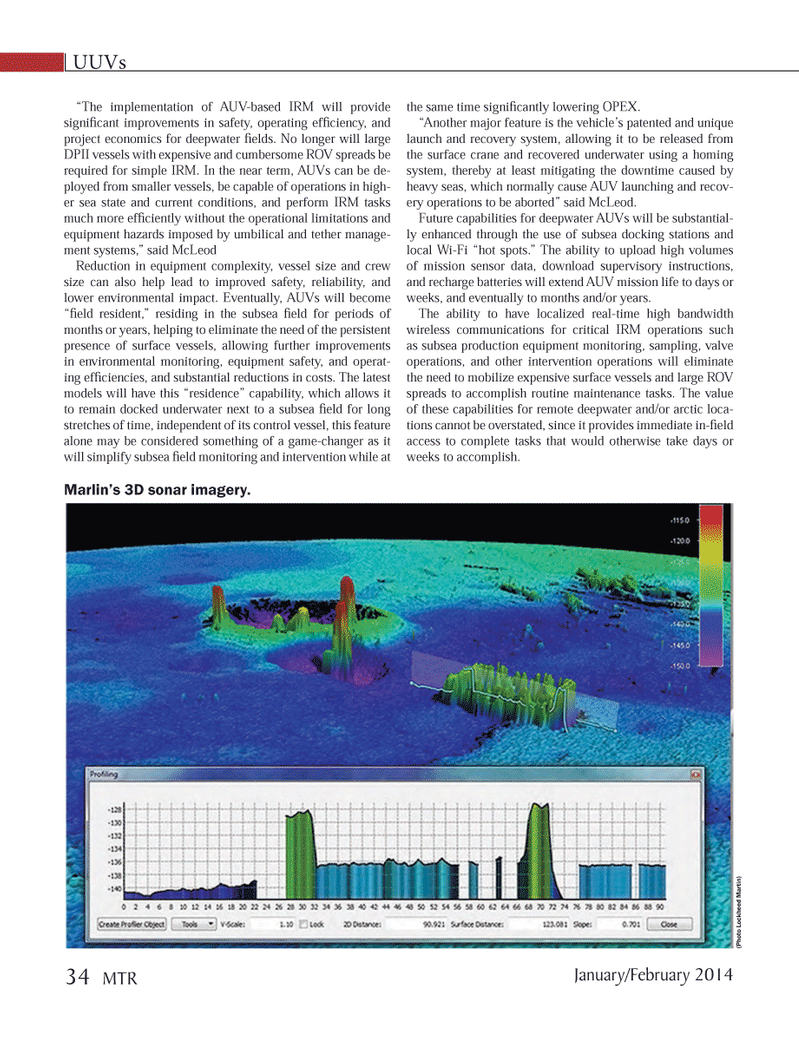
Page 34: of Marine Technology Magazine (January 2014)
Subsea Vehicles: UUVs
Read this page in Pdf, Flash or Html5 edition of January 2014 Marine Technology Magazine
?The implementation of AUV-based IRM will provide signi cant improvements in safety, operating ef ciency, and project economics for deepwater elds. No longer will large DPII vessels with expensive and cumbersome ROV spreads be required for simple IRM. In the near term, AUVs can be de- ployed from smaller vessels, be capable of operations in high- er sea state and current conditions, and perform IRM tasks much more ef ciently without the operational limitations and equipment hazards imposed by umbilical and tether manage-ment systems,? said McLeod Reduction in equipment complexity, vessel size and crew size can also help lead to improved safety, reliability, and lower environmental impact. Eventually, AUVs will become ? eld resident,? residing in the subsea eld for periods of months or years, helping to eliminate the need of the persistent presence of surface vessels, allowing further improvements in environmental monitoring, equipment safety, and operat- ing ef ciencies, and substantial reductions in costs. The latest models will have this ?residence? capability, which allows it to remain docked underwater next to a subsea eld for long stretches of time, independent of its control vessel, this feature alone may be considered something of a game-changer as it will simplify subsea eld monitoring and intervention while at the same time signi cantly lowering OPEX. ?Another major feature is the vehicle?s patented and unique launch and recovery system, allowing it to be released from the surface crane and recovered underwater using a homing system, thereby at least mitigating the downtime caused by heavy seas, which normally cause AUV launching and recov- ery operations to be aborted? said McLeod. Future capabilities for deepwater AUVs will be substantial- ly enhanced through the use of subsea docking stations and local Wi-Fi ?hot spots.? The ability to upload high volumes of mission sensor data, download supervisory instructions, and recharge batteries will extend AUV mission life to days or weeks, and eventually to months and/or years. The ability to have localized real-time high bandwidth wireless communications for critical IRM operations such as subsea production equipment monitoring, sampling, valve operations, and other intervention operations will eliminate the need to mobilize expensive surface vessels and large ROV spreads to accomplish routine maintenance tasks. The value of these capabilities for remote deepwater and/or arctic loca- tions cannot be overstated, since it provides immediate in- eld access to complete tasks that would otherwise take days or weeks to accomplish.UUVs(Photo Lockheed Martin) Marlin?s 3D sonar imagery. January/February 2014 34 MTRMTR #1 (34-49).indd 34MTR #1 (34-49).indd 341/23/2014 10:45:44 AM1/23/2014 10:45:44 AM

 33
33

 35
35
